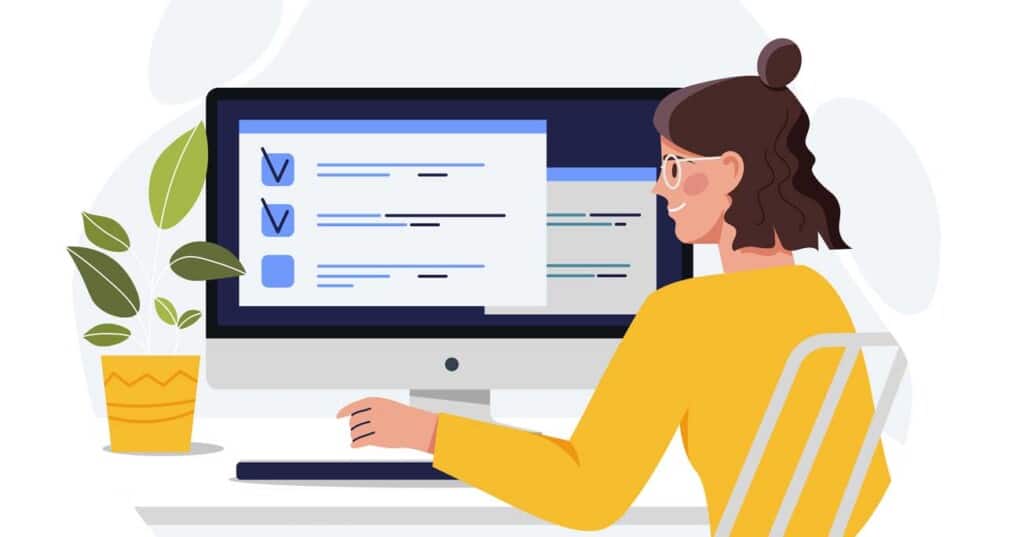
How To Conduct Effective User Testing
Table of Contents
TLDR
User testing is essential for improving website performance by enhancing user experience, identifying usability issues, and informing design decisions.
This comprehensive guide covers the entire process: setting clear objectives, selecting the right participants, choosing appropriate testing methods, designing realistic test scenarios and tasks, preparing prototypes, and setting up a testing environment. It also includes best practices for conducting tests, analysing results, prioritising issues, and implementing changes through an iterative process.
Introduction

The Power of User Testing
User testing is indispensable to web design, yet it’s often underestimated,ignored and dropped to suit clients’ budgets. Did you know that according to a study by the Nielsen Norman Group, 85% of all usability problems can be identified by testing with just five users? This staggering statistic underscores the power of user testing in pinpointing issues that can make or break a website’s performance.
Purpose of This Guide
This article aims to provide you with a guide on conducting effective website usability testing to improve your website, from understanding its significance and preparing for the test to designing the test itself and implementing the findings. By the end of this guide, you’ll be equipped with the knowledge and tools to conduct user testing that enhances your website’s user experience.
What You Will Learn
I’ll begin by exploring what user testing entails and why it is crucial for any website’s success. Next, I’ll cover the preparatory steps, such as setting objectives, identifying your target audience, and selecting the appropriate testing method. Following this, I’ll discuss designing a practical test, including creating realistic scenarios and actionable tasks, preparing prototypes, and setting up the testing environment.
Then, I’ll move on to the actual conduct of the test, offering tips on recruiting participants, facilitating the test, and recording observations. After gathering data, I’ll guide you through analysing the results, identifying patterns, and prioritising issues based on their impact. Lastly, I’ll address how to implement changes, iterate on designs, and collaborate with your team, all while sharing real-world examples to illustrate successful user testing.
• • •
Understanding User Testing

What is User Testing in Web Design?
In web design, user testing involves observing real users as they interact with your website to identify areas of confusion, frustration, or difficulty. Essentially, it’s about putting your website in front of users and seeing how they navigate and use it, providing invaluable insights into how users behave.
Why is User Testing Critical for Website Improvement?
Conducting user testing is valuable for several reasons, and I firmly believe it’s one of the most effective tools for refining and enhancing a website.
- Enhancing User Experience – First and foremost, user testing enhances the user experience (UX). By understanding how real users interact with your site, you can make informed adjustments that make the interface more intuitive and enjoyable. A better UX can increase engagement, extended visits, and conversion rates.
- Identifying Usability Issues – User testing helps identify usability issues that might not be apparent during the design and development phases. These could range from confusing navigation and unclear call-to-action buttons to more complex problems like accessibility barriers. Recognising and addressing these issues ensures your site is user-friendly and accessible to a broader audience.
- Informing Design Decisions – User testing provides data to inform your design decisions. Instead of relying on assumptions or personal preferences, you see what actually works for your users. This data-driven approach helps create a design that meets user needs and expectations, leading to a more successful website overall.
- Types of User Testing – There are various methods of user testing, each offering unique benefits depending on your goals and resources. Here’s a brief overview:
- A/B Testing – Also known as split testing, involves comparing two webpage versions to see which performs better. By showing different versions to different users, you can determine which design, content, or layout changes yield the best results.
- Usability Testing – is a method in which users are asked to complete specific tasks while observers watch and take notes. This type of testing helps identify where users struggle and what changes can enhance the overall usability of the site.
- Remote User Testing – Remote user testing allows users to test the website from their location using their own devices. This method is beneficial for getting diverse feedback, as it can include participants from different geographical locations and backgrounds.
• • •
Preparing for User Testing

Setting Testing Objectives
The first step when preparing for user testing is to set clear objectives. Without well-defined goals, the process can become unfocused and ineffective. I always ask myself, “What do I want to learn from this testing session?” Your objectives might include understanding how easily users can navigate the site, identifying specific pain points in the user journey, or testing the effectiveness of a new feature. You can design your testing sessions to yield the most relevant and actionable insights by having particular, measurable goals.
Example Objectives:
- Determine if users can easily find and use the main navigation menu.
- Identify any confusion during the checkout process.
- Assess the impact of new design elements on user engagement.
Identifying Target Users
Next, it’s crucial to identify your target audience. Knowing your users will help you select test participants who represent your user base. This step is vital because feedback from the right users will be more relevant and actionable. I recommend creating user personas to visualise the different types of users interacting with your website. These personas should include demographics, behaviours, and needs.
Steps to Identify Target Audience:
- Demographics: Consider age, gender, location, and other demographic factors that describe your typical users.
- User Behaviour: Consider how your users interact with your site, their goals, and any common challenges they face.
- Recruitment: Use these criteria to recruit participants who match your user personas. This could involve reaching out to your customer base, using social media, or employing user testing platforms that can find participants for you.
Selecting the Right Testing Method
Choosing the right testing method is critical to achieving your objectives. Different methods provide different insights, so matching the technique to your goals and resources is essential. Here’s how I approach selecting the appropriate testing method:
A/B Testing
- Best For: Comparing two webpage versions to see which performs better.
- Resources Needed: Access to tools that can segment traffic and measure performance metrics.
- Considerations: Ideal for testing specific changes like button colours or headlines.
Usability Testing
- Best For: Identifying general usability issues and understanding user behaviour.
- Resources Needed: A moderator, recording equipment, and a structured test plan.
- Considerations: This can be done in person or remotely but requires careful observation and note-taking.
Remote User Testing
- Best For: Getting feedback from diverse users in their natural environment.
- Resources Needed: Tools for screen sharing and recording and a way to recruit participants remotely.
- Considerations: It allows for a broader range of participants but can be harder to control in the testing environment.
Steps to Select the Right User Testing Method:
- Align with Objectives: Choose a method that directly addresses your testing goals. For example, usability testing might be best if you want to understand user interactions.
- Assess Resources: Consider the tools, time, and budget available. A/B testing might require technical resources, while usability testing might require more analysis time.
- Pilot Testing: Conduct a small pilot test to ensure your chosen method works as expected and refine your approach before the entire testing session.
These steps ensure that your efforts are focused, efficient, and practical, leading to a better user experience and, ultimately, a more successful website.
• • •
Designing the Test

Creating Test Scenarios
When designing the test, the first step is to create realistic scenarios that users will perform. These scenarios should mimic real-life situations and tasks that users typically encounter on your website. I always start by mapping out the user journey and identifying key actions and goals that users might have. This helps me create relevant and comprehensive scenarios.
Example Scenarios:
- E-commerce Site: A user wants to find and purchase a specific product.
- Blog or News Site: A user seeks articles on a particular topic.
- Service Website: A user must contact customer support or find service information.
By developing scenarios that reflect actual user behaviour, you can ensure that the testing provides insights directly applicable to improving your website’s usability.
Write Clear, Actionable Tasks
Once you have your scenarios, the next step is to design tasks that users will complete during the test. These tasks should be clear, specific, and actionable, reflecting typical user actions on your website. I find that tasks should be simple yet structured enough to guide users without leading them too much.
Example Tasks:
- Find and add a product to your shopping basket, then checkout.
- Locate an article on web design trends 2024 and share it on social media.
- Use the contact form to ask a question about the services offered.
Each task should have a clear start and end point, allowing you to observe how users navigate and interact with your site to complete the task. Avoid vague instructions and ensure tasks are achievable within the scope of the test.
Decide on Testing Material
Deciding whether to use wireframes, mockups, or a live website depends on the stage of your design process and the objectives of your test. I prefer to use different materials based on the specific insights I’m seeking:
Wireframes:
- Best For: Early-stage testing to validate layout and navigation structure.
- Pros: Simple and quick to create, helps focus on usability without visual distractions.
Mockups:
- Best For: Mid-stage testing to assess design elements and visual hierarchy.
- Pros: More detailed than wireframes, allows testing of visual design aspects.
Live Website:
- Best For: Late-stage testing to evaluate overall user experience and functionality.
- Pros: Provides the most accurate feedback as users interact with a fully functional site.
By choosing the appropriate prototype, you can ensure that the feedback you receive is relevant and actionable for the current stage of your design process.
Setting Up Testing Environment
The final step in designing the test is setting up the testing environment. This involves ensuring you have the necessary tools and software to record and observe user interactions. I recommend using a combination of screen recording software, usability testing tools, and note-taking apps to capture all relevant data.
Essential Tools:
- Screen Recording Software: Tools like Loom or OBS Studio to capture user interactions and behaviours.
- Usability Testing Platforms: Services like UserTesting or Lookback that provide comprehensive usability testing solutions.
- Note-Taking Apps: Tools like Evernote or OneNote for documenting observations and insights during the test.
Setting Up:
- Environment Preparation: Ensure a quiet, distraction-free environment for in-person tests. For remote tests, provide clear instructions on how users should set up their environment.
- Testing Software: Install and configure all necessary software ahead of time, ensuring it works seamlessly.
- Backup Plans: Have a backup plan in case of technical issues, such as alternative recording methods or secondary devices.
By preparing the testing environment, you can ensure that you conduct usability testing that runs smoothly and that you capture high-quality data. This preparation is crucial for obtaining reliable and actionable insights to drive meaningful website improvements.
• • •
Conducting the Test

Tips for Finding and Selecting Participants
Recruiting the right participants is a cornerstone of effective user testing. The goal is to find users who accurately represent your target audience. Here’s how I approach this crucial step:
- Define Criteria: Based on your user personas, start by defining the characteristics of your ideal participants. Consider demographics, user behaviour, and familiarity with similar websites or products.
- Use Multiple Channels: Leverage various channels to recruit participants, such as social media, email lists, user testing platforms (like UserTesting or TryMyUI), and even personal networks.
- Incentivise Participation: Offering incentives such as gift cards, discounts, or monetary compensation can motivate users to participate in your tests.
- Screen Participants: Use screening surveys to ensure participants meet your criteria. This helps in filtering out those who might not provide relevant insights.
Example Recruitment Message:
“We’re looking for individuals aged 25-45 who frequently shop online to participate in a usability study for our e-commerce website. Participants will receive a £25 Amazon gift card for their time.”
Facilitating the User Test
Facilitating a website usability test effectively requires a balance between guiding participants and allowing them to interact naturally with the website. Here are some best practices I follow:
- Prepare a Script: Have a script ready that outlines the tasks and questions but allows for flexibility. This ensures consistency across sessions while accommodating spontaneous feedback.
- Neutral Moderation: As a moderator, maintain a neutral tone and avoid leading questions. For instance, instead of asking, “Do you find this button easy to use?” ask, “What do you think about this button?”
- Encourage Think-Aloud Protocol: Encourage participants to verbalise their thoughts as they navigate the site. This will provide insights into their thought process and highlight areas of confusion.
- Observe and Note: Focus on observing user behaviour and taking notes. Please resist the urge to correct or assist participants during the test, as this can influence their natural interactions.
Example Script Excerpt:
“Please find and add a product to your cart. As you do this, please talk out loud and let me know what you’re thinking and feeling.”
Recording Observations: Methods for Capturing Data
Recording observations accurately is essential for analysing and acting on the insights gathered during user testing. Here are the methods I typically use:
- Screen Recordings: Screen recording software captures the entire session, including the user’s interactions and verbal comments.
- Audio and Video Recording: If possible, record both audio and video to capture non-verbal cues such as facial expressions and body language, which can provide additional context to their feedback.
- Live Notes: Take detailed notes during the session, focusing on key actions, difficulties encountered, and any notable comments made by the participant. Tools like Evernote or OneNote can be handy for organising these notes.
- Post-Session Surveys: After the session, ask participants to complete a brief survey to gather additional feedback and their overall impressions.
Example Observation Note:
“Participant struggled to find the ‘Add to Cart’ button, mentioning it was not immediately visible. It took 30 seconds to locate it, then commented on its small size and lack of contrast.”
These steps ensure that the insights you collect are reliable, actionable, and truly reflective of user needs and behaviours.
• • •
Analysing the Results

Data Collection
Once you’ve completed your user testing sessions, the next step is to organise and categorise your gathered data. This process begins by reviewing all the recordings, notes, and survey responses. I recommend creating a centralised repository to store and access all the data easily.
- Transcribe and Summarise: Start by transcribing key parts of your recordings and summarising the main observations. This makes it easier to sift through the data later.
- Categorise Observations: Group similar observations together. For instance, all comments and behaviours related to navigation can be categorised under “Navigation Issues.”
- Use Spreadsheets or Tools: Organise data using spreadsheets or specialised tools like Trello or Airtable. Create columns for different categories, such as usability issues, user comments, task completion times, and error occurrences.
Example Categories:
- Navigation Issues
- Content Clarity
- Visual Design Feedback
- Functional Errors
- Positive Feedback
Identifying Patterns
With the data organised, the next step is to identify patterns and common themes in user feedback. This is where you start to see the bigger picture of user experience and usability.
- Frequency Analysis: Look for issues that multiple users encountered. The more frequently a problem is reported, the more critical it is likely to be.
- Thematic Analysis: Identify recurring themes in user comments and behaviours. For example, if several users mention difficulty finding specific information, this indicates a problem with content discoverability.
- Behavioural Patterns: Observe how different users navigate through similar tasks. Patterns in user behaviour can reveal underlying issues that might not be immediately apparent from verbal feedback alone.
Example Patterns:
- Multiple users struggled with the search functionality, either not finding what they were looking for or finding irrelevant results.
- Users consistently expressed confusion over the layout of the product details page.
- Positive feedback was frequently given regarding the simplicity and cleanliness of the homepage design.
Prioritising Issues
After identifying common issues and themes, it’s essential to prioritise these based on their impact on the user experience. Not all problems are created equal; some will significantly affect user satisfaction and conversion rates.
- Severity and Frequency: Prioritise issues that are both severe and frequent. An issue that significantly hampers task completion or frustrates users should be addressed urgently.
- Impact on Business Goals: Consider how each issue impacts your business goals. For instance, problems affecting an e-commerce site’s checkout process should be a top priority.
- Effort to Fix: Evaluate the effort required to fix each issue. Quick wins can rapidly boost user experience, while more complex issues may need to be scheduled as part of a larger redesign.
- User Feedback: Take into account the weight of user feedback. If users are vocal about a particular issue, it’s likely a priority, even if it wasn’t observed as frequently.
Example Prioritisation:
- High Priority: Fix the search functionality to provide more accurate results, as it directly affects users’ ability to find products.
- Medium Priority: Redesign the product details page to enhance clarity and user comprehension.
- Low Priority: Address minor visual design tweaks that, while beneficial, do not significantly impact usability or user satisfaction.
By collecting and organising your data, identifying recurring patterns and themes, and prioritising issues based on their severity and impact, you can create a clear roadmap for website improvements.
• • •
Implementing Changes

Design Solutions
Once you’ve identified the critical issues from your user testing, the next step is to develop and propose practical solutions. This phase is where the insights from testing are transformed into actionable design improvements. I always begin by brainstorming with my team to generate various possible solutions for each identified problem. Consider the user feedback and patterns observed during the testing phase.
Example Solutions:
- Search Functionality: Improve the search algorithm to yield more relevant results. This might involve enhancing keyword matching and refining search filters.
- Navigation: Simplify the navigation menu by grouping related items and adding clear labels.
- Product Details Page: Redesign the layout to highlight key information, such as pricing, product features, and customer reviews, more prominently.
By developing solutions, you ensure that the changes address the specific issues identified during testing.
Iteration Process
Implementing changes is not a one-time task but an iterative process. Iteration is crucial because it allows you to refine and enhance your solutions based on user feedback and real-world usage.
- Implement Initial Changes: Start by making the most critical adjustments identified from the user testing.
- Conduct Follow-Up Tests: After implementing changes, conduct follow-up tests to evaluate their effectiveness. This helps ensure that the adjustments resolve the issues without introducing new problems.
- Continuous Improvement: Use feedback from follow-up tests to make further refinements. The goal is to create a continuous improvement cycle where user testing and iteration are ongoing parts of your design process.
Example Iteration Process:
- Initial Test Results: Users found the search function inadequate.
- First Iteration: Implemented an improved search algorithm and added search filters.
- Follow-Up Test: Conducted another round of user testing to assess the changes. Results showed improved satisfaction but revealed a need for better filter options.
- Second Iteration: Enhanced filter options based on the latest feedback and tested again.
Working with Your Design and Development Team
Successful implementation of changes requires close collaboration between designers, developers, and other stakeholders. I find that regular communication and a collaborative approach are key to ensuring that everyone is aligned and working towards the same goals.
- Regular Meetings: Meet regularly to discuss progress, share feedback, and address challenges. This keeps the team informed and engaged.
- Shared Documentation: Use shared documents and project management tools to keep track of changes, feedback, and testing results. This ensures transparency and accessibility of information.
- Cross-Functional Teams: Foster a culture of collaboration by involving team members from different disciplines in the decision-making process. This brings diverse perspectives and expertise to the table, enhancing the quality of the solutions.
Example Collaboration Strategy:
- Kickoff Meeting: Meet with designers, developers, and product managers to review the testing results and proposed solutions.
- Implementation Phase: Developers work on coding the changes while designers refine the user interface.
- Review and Feedback: Hold a review session to evaluate the changes and gather feedback from the entire team before conducting follow-up tests.
By developing thoughtful design solutions, iterating based on user feedback, and fostering strong collaboration within your team, you can implement changes that significantly improve your website’s usability and user experience.
• • •
Case Studies and Examples

Successful User Testing Stories
To illustrate the power of user testing, let’s look at a few real-world examples where companies have significantly improved their websites through user testing.
Example 1: Catch
Catch is a prime example of a company that prioritises user testing to enhance its platform. Early in its development, Catch faced challenges with users having difficulty navigating the site and completing bookings. By conducting extensive user testing, they discovered users were struggling with the search functionality and the booking process.
Changes Implemented:
- We have simplified the search interface to make it more intuitive.
- We have streamlined the booking process by reducing the steps required to complete a reservation.
Results:
These changes led to an increase in user satisfaction and conversion rates. The streamlined booking process made it easier for users to complete their transactions, ultimately boosting Catch’s revenue.
Example 2: CSYIAM
Cysiam used user testing to improve its data capture and reporting process. They found that new users were often consultants and clients who were confused about how to get started with the platform.
Changes Implemented:
- Redesigned the data capture flow to provide more precise, step-by-step instructions.
- They added interactive tutorials to guide new users through the process.
Results:
The improved experience resulted in higher data accuracy and faster adoption of the platform’s features. Users felt more confident using CYSIAM, which contributed to their rapid growth.
Key Takeaways from Case Studies
These case studies offer valuable lessons for anyone looking to improve their website through user testing:
- Understand User Pain Points: User testing can reveal specific areas where users struggle, allowing you to address these pain points directly. They all identified critical issues hindering user experience and took targeted actions to resolve them.
- Simplify User Experience: Simplifying processes and interfaces can significantly improve user satisfaction and conversion rates. Whether it’s simplifying the search function or the data collection process, a more straightforward user experience is always beneficial.
- Iterate Based on Feedback: Continuous iteration and refinement based on user feedback are essential. Each of these companies implemented changes and continued testing and refining their solutions, leading to ongoing improvements.
By examining these successful user testing stories, it becomes clear that investing in user testing is about fixing problems and creating a more intuitive, engaging, and satisfying user experience.
• • •
In Summary

In this article, we’ve explored the critical role of user testing in improving website performance. We started by defining user testing and highlighting its importance in enhancing user experience, identifying usability issues, and informing design decisions. We then delved into the preparatory steps, including setting objectives, identifying the target audience, and selecting the appropriate testing method.
We discussed designing the test by creating realistic scenarios and tasks, preparing prototypes, and setting up the testing environment. Next, we covered conducting the test, from recruiting participants to facilitating the sessions and recording observations. We also examined how to analyse the results by organising data, identifying patterns, and prioritising issues.
Finally, we discussed implementing changes, the importance of iteration, and collaborating with your team, and shared real-world case studies to illustrate the impact of user testing.
I encourage you to start your user testing process today. The insights you gain will be invaluable in creating a better user experience and driving the success of your website. Don’t wait; set clear objectives and select the right participants. Use the tools and techniques this article discusses to conduct your tests and analyse the results. For further guidance, explore the additional resources below.
Additional Resources
Tools and Software
- UserTesting: A comprehensive platform for remote user testing.
- Lookback: A tool for live user testing and interviews.
- Hotjar or Microsoft Clarity: This is for heatmaps, session recordings, and user feedback.
- Optimal Workshop: For card sorting and tree testing.
- Crazy Egg: Provides heatmaps and A/B testing.
Further Reading
- “Don’t Make Me Think” by Steve Krug
- “The User Experience Team of One” by Leah Buley
- “Lean UX” by Jeff Gothelf
- The Ultimate Guide to Usability Testing” by Interaction Design Foundation
- “A Comprehensive Guide to User Testing” by Smashing Magazine
- “How to Conduct Remote User Testing” by Nielsen Norman Group
- “UX Research and Design” by Coursera
- “Usability Testing Bootcamp” by Udemy
- “Human-Computer Interaction” by edX





